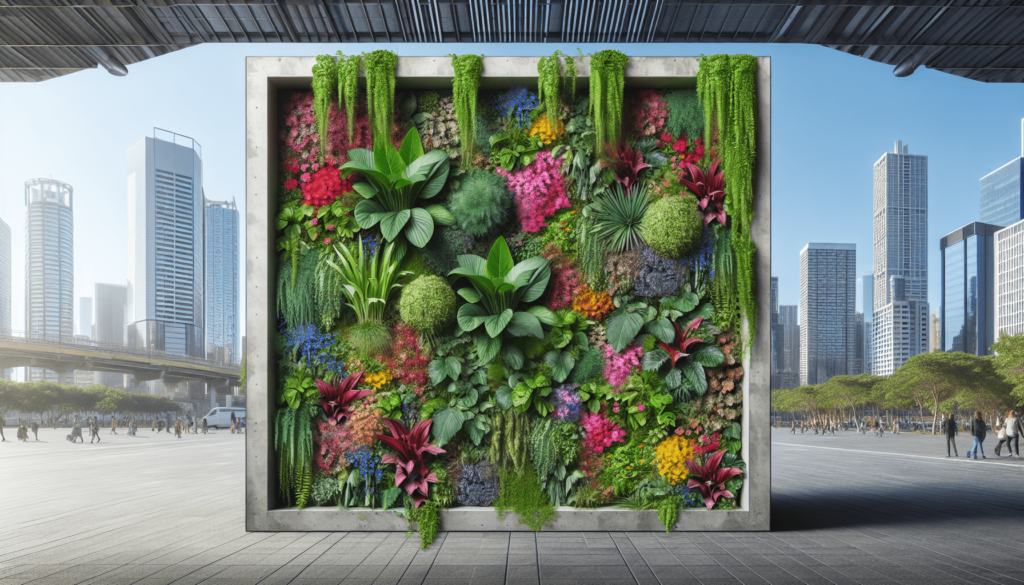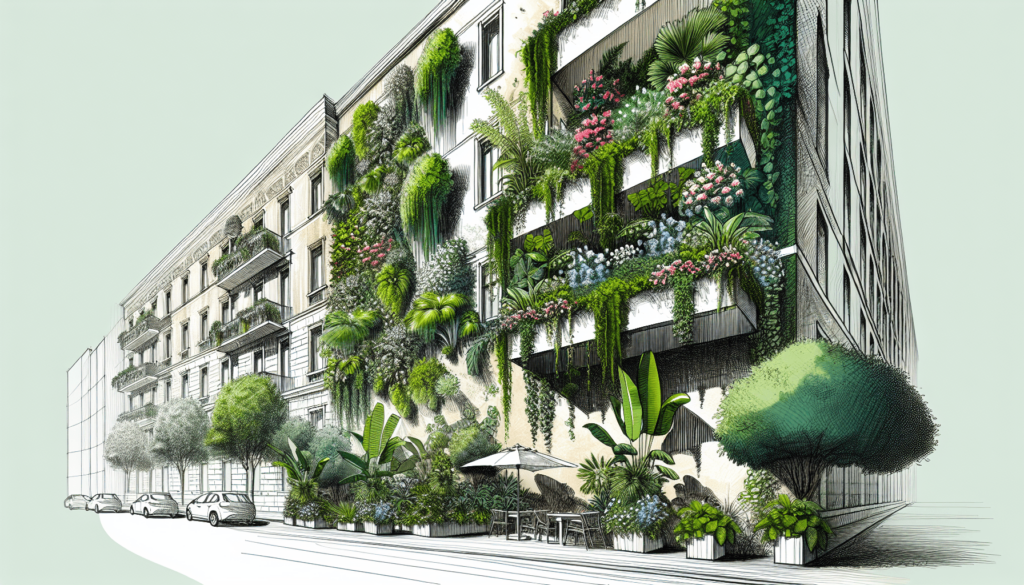Disclosure: As participants in the Amazon Associates Program, we earn from qualifying purchases. This means when you click on an Amazon link on this page and make a purchase, we receive a commission. This doesn’t affect the price you pay but it does help us to keep producing the content you love to see. We always aim for honesty and transparency in everything we do, and your support means the world to us. Thank you for helping us grow and for being part of our community.
Imagine a world where your dull, lifeless spaces can be magically transformed into vibrant, green havens. That’s the vision behind our website, a haven for vertical gardening enthusiasts seeking inspiration, knowledge, and practical tips to create their own stunning vertical gardens. From setting up your first vertical garden to exploring the latest trends in horticulture, our carefully curated articles cover all aspects of vertical gardening. We even compare different vertical garden kits to help you find the perfect fit for your needs. Join our community of like-minded gardeners and let’s turn drab into fab, one vertical garden at a time.

This image is property of pixabay.com.
Benefits of Vertical Gardens
Improving air quality
Vertical gardens have a significant impact on improving air quality. They have the ability to capture and filter harmful pollutants, such as carbon dioxide and toxic chemicals, from the air. Through a process called phytoremediation, plants in vertical gardens absorb these pollutants and convert them into oxygen, thus purifying the air we breathe.
Enhancing aesthetics
Vertical gardens are not only practical but also visually stunning. They add a touch of natural beauty to any space, whether it’s a small urban apartment or a large commercial building. With a variety of plant species and colors to choose from, vertical gardens can be customized to suit your personal style. They create a vibrant and inviting atmosphere, making your surroundings more aesthetically pleasing.
Increasing green space
One of the most significant benefits of vertical gardens is their ability to maximize green space in urban areas. As cities become more crowded, open spaces and parks are often limited. Vertical gardens offer a solution by utilizing vertical walls or structures to create a lush green oasis. They enable you to bring nature closer, even in tight spaces, and enjoy the benefits of greenery without sacrificing valuable floor space.
Reducing energy consumption
Vertical gardens can help reduce energy consumption in buildings. By acting as natural insulation, they help regulate temperature, keeping the surrounding areas cooler in the summer and warmer in the winter. This reduces the need for artificial heating and cooling, ultimately lowering energy costs. Additionally, vertical gardens can shade buildings, reducing the amount of direct sunlight and preventing heat gain.
Providing insulation
Vertical gardens act as an additional layer of insulation for buildings. They create an insulating barrier between the interior and exterior walls, reducing thermal conductivity and heat transfer. This results in a more stable and comfortable indoor environment, decreasing the reliance on heating and cooling systems. As a result, energy consumption is reduced, helping to lower carbon emissions and promote sustainable living.
Mitigating noise pollution
Vertical gardens have the ability to absorb and deflect sound, making them an effective solution for mitigating noise pollution. The layers of foliage in vertical gardens act as sound barriers, reducing the impact of noise from traffic, construction, or other external sources. By creating a quieter environment, vertical gardens contribute to a more peaceful and serene atmosphere, improving the overall quality of life.
Choosing the Right Vertical Garden Kit
Consider space limitations
When choosing a vertical garden kit, it’s important to consider the available space. Determine the size and dimensions of your desired vertical garden area to ensure it fits properly. If you have limited space, opt for a compact or modular system that can be easily customized and adjusted as needed.
Evaluate the growing conditions
Different plants thrive in different growing conditions. Before selecting a vertical garden kit, evaluate the amount of sunlight and shade your chosen location receives. Some kits are designed for full sun exposure, while others are more suitable for shady areas. Matching the growing conditions with the kit will ensure the success of your vertical garden.
Select suitable plant types
Consider the types of plants you want to grow and ensure they are compatible with the vertical garden kit you choose. Some kits are designed specifically for herbs or vegetables, while others are better suited for ornamental plants or flowering vines. Selecting the right plant types will help ensure optimal growth and a thriving vertical garden.
Check the ease of installation
Look for a vertical garden kit that is easy to install and doesn’t require complicated tools or extensive construction. Consider kits that provide clear instructions and include all necessary mounting hardware. The easier the installation process, the quicker you can begin enjoying your vertical garden.
Compare irrigation systems
Different vertical garden kits utilize various irrigation systems. Some may include self-watering features or built-in irrigation systems, while others may require manual watering. Consider your preferences and the specific needs of your chosen plants when selecting a kit. Ensure that the irrigation system is efficient and allows for proper water distribution.
Assess maintenance requirements
Each vertical garden kit may have different maintenance requirements. Consider the amount of time and effort you’re willing to dedicate to maintenance tasks such as watering, pruning, and fertilizing. Choose a kit that aligns with your maintenance capabilities and ensure that it provides easy access to maintain the health of your plants.

This image is property of pixabay.com.
Setting Up Your Vertical Garden
Evaluate the structural support
Before setting up your vertical garden, evaluate the structural support of the chosen wall or surface. Vertical gardens can be heavy, especially when fully grown, so it’s essential to ensure that the wall or structure can support the weight. If needed, reinforce the wall or consult a professional for assistance.
Prepare the wall or surface
Prepare the wall or surface by cleaning it thoroughly and making any necessary repairs. Remove any loose paint, debris, or dirt to provide a clean, smooth surface for the vertical garden. Consider applying a waterproof sealant to protect the wall from moisture and prevent damage.
Install the vertical garden kit
Follow the manufacturer’s instructions to install the vertical garden kit. This may involve attaching mounting brackets or hooks onto the wall and securing the supporting structure. Ensure that the kit is securely attached to prevent any movement or instability.
Arrange plants and containers
Once the vertical garden kit is installed, arrange the plants and containers according to your desired design. Consider the growth patterns and space requirements of each plant to ensure proper spacing and optimal growth. Experiment with different arrangements until you achieve the desired aesthetic and functionality.
Ensure proper drainage
Proper drainage is crucial to the health of your vertical garden. Ensure that the containers or pockets provided by the kit have sufficient drainage holes to prevent water from pooling. This will help prevent waterlogged soil and root rot. Consider using a layer of rocks or gravel at the bottom of each container to aid in drainage.
Establish a watering schedule
Establishing a watering schedule is essential to maintain the health of your vertical garden. Vertical gardens may require more frequent watering due to their vertical orientation and increased exposure to sunlight and wind. Monitor the moisture levels of the soil regularly and adjust the watering schedule accordingly. Avoid overwatering or allowing the soil to dry out completely.
Choosing Plants for Vertical Gardens
Selecting based on sunlight requirements
Different plants have different sunlight requirements. Some thrive in full sun, while others prefer partial shade. Consider the amount of sunlight your vertical garden receives and select plants accordingly. Ensure that the selected plants can tolerate the specific light conditions of your chosen location.
Choosing plants based on water needs
Plants have varying water needs, ranging from drought-tolerant species to those that require more frequent watering. Assess the watering capabilities of your vertical garden and select plants that align with your watering routine. Avoid mixing plants with drastically different water requirements to ensure balanced watering for all plants.
Consider the size and weight of plants
When choosing plants for your vertical garden, consider their mature size and weight. Ensure that the vertical garden kit and supporting structure can accommodate the growth of the plants without causing instability or damage. Choose plants that will not overwhelm the vertical garden and maintain a balanced visual aesthetic.
Opt for plants with shallow root systems
Vertical gardens typically have limited soil depth, so selecting plants with shallow root systems is essential. Plants with shallow roots adapt well to the confined environment of a vertical garden and can establish themselves more easily. Avoid plants with deep taproots or those that require extensive root space.
Including a mix of foliage and flowering plants
To add visual interest and variety to your vertical garden, include a mix of foliage and flowering plants. Foliage plants provide a lush green backdrop and can help create a sense of depth, while flowering plants add pops of color and vibrancy. Strive for a balanced combination of textures, colors, and forms.
Considering edibles for functional vertical gardens
If you’re looking to add functionality to your vertical garden, consider including edible plants. Herbs, vegetables, and fruits can be grown vertically, providing a fresh and convenient source of food. Choose edible plants that suit your taste preferences and growing conditions. Vertical gardens offer a unique opportunity to create your own edible oasis.

This image is property of pixabay.com.
Maintaining a Vertical Garden
Watering and irrigation techniques
Proper watering is crucial for maintaining a healthy vertical garden. Monitor the moisture levels of the soil regularly and adjust the watering schedule as needed. Consider using drip irrigation systems or self-watering containers to ensure efficient water distribution. Be mindful not to overwater or underwater your plants, as both can lead to health issues.
Fertilizing and soil management
Regular fertilization is necessary to provide essential nutrients for vertical garden plants. Use a balanced, slow-release fertilizer to nourish the soil and promote healthy growth. Follow the manufacturer’s instructions for application rates and frequency. Additionally, monitor the soil quality and pH level to maintain optimal growing conditions.
Pruning and trimming
Periodically prune and trim your vertical garden to maintain its shape and prevent overcrowding. Remove any dead or diseased foliage, as well as any branches that impede the growth of adjacent plants. Pruning also encourages new growth and allows for better air circulation within the vertical garden.
Managing pests and diseases
Vertical gardens are not immune to pests and diseases. Regularly inspect your plants for any signs of infestation or disease. Use organic pest control methods whenever possible to avoid harmful chemicals. Treat any pest or disease issues promptly to prevent further damage to your vertical garden.
Replacing or rotating plants
Over time, some plants may become less healthy or less visually appealing. Consider replacing these plants with new ones to maintain the overall beauty and vitality of your vertical garden. Additionally, rotating plants periodically can help ensure equal access to sunlight and prevent overcrowding.
Regularly monitoring and adjusting
Maintaining a vertical garden requires regular monitoring and adjustment. Observe your plants closely, noting any changes in growth patterns, foliage color, or overall health. Be proactive in addressing any issues that may arise, such as nutrient deficiencies, dehydration, or pest infestations. Regular monitoring ensures the long-term success of your vertical garden.
Creative Ideas for Vertical Gardens
Creating a living wall art
A vertical garden can be transformed into a living work of art. Choose plants with different textures, colors, and growth habits to create a visually appealing design. Experiment with various plant combinations and arrangements to achieve an artistic and unique living wall.
Building a herb or vegetable garden
Vertical gardens are ideal for growing herbs and vegetables, even in limited spaces. Create a functional kitchen garden by selecting herbs and vegetables that you frequently use in your cooking. This way, you’ll have fresh, aromatic ingredients right at your fingertips.
Designing a hanging succulent display
Succulents are well-suited for vertical gardens due to their low water requirements and unique shapes. Design a hanging succulent display by selecting a variety of succulent species and arranging them in containers or pockets within your vertical garden. Create a cascading effect with trailing succulents for a visually stunning display.
Creating a cascading flower wall
Flowering plants can add a burst of color and beauty to your vertical garden. Create a cascading flower wall by selecting trailing or vining plants with vibrant blooms. Arrange them strategically, allowing the flowers to spill over and create a cascading effect, reminiscent of a waterfall of flowers.
Incorporating vertical gardens in small spaces
Vertical gardens are a perfect solution for small spaces. Whether it’s a balcony, patio, or even a narrow alley, vertical gardens can transform these confined spaces into lush green sanctuaries. Use modular vertical garden systems or hanging planters to maximize the use of vertical space.
Exploring vertical hydroponic systems
For those interested in advanced gardening techniques, vertical hydroponic systems offer an innovative approach to vertical gardening. These systems use water and nutrient solutions instead of soil to cultivate plants. Explore the world of vertical hydroponics and discover the benefits of soilless gardening.

Enhancing Vertical Gardens with Accessories
Using trellises and supports
Trellises and supports can add structure and visual interest to vertical gardens. Install trellises or vertical supports to guide vertical growth and provide a framework for climbing plants. This not only enhances the aesthetic appeal but also creates additional planting opportunities.
Adding decorative planters and containers
Elevate the visual appeal of your vertical garden by using decorative planters and containers. Choose containers in different materials, shapes, and colors that complement the overall design. Consider incorporating hanging planters or tiered containers to add depth and dimension.
Incorporating lighting fixtures
Illuminate your vertical garden and create a magical atmosphere by incorporating lighting fixtures. Use LED lights strategically to highlight focal points, plants with unique foliage, or create a soft ambiance in the evening. Lighting not only enhances the beauty of your vertical garden but also extends its visual impact into the night.
Installing automated irrigation systems
Automated irrigation systems can simplify the watering process and ensure consistent moisture levels. Install a drip system or a timer-controlled irrigation system within your vertical garden for efficient and automated watering. This saves time and effort while ensuring optimal growing conditions for your plants.
Including bird feeders and houses
Enhance the biodiversity of your vertical garden by including bird feeders and birdhouses. Birds bring life and movement to your green space while also providing natural pest control. Choose bird feeders and houses that match the aesthetic of your vertical garden and create a welcoming environment for feathered friends.
Using vertical garden art and sculptures
Take your vertical garden to the next level by incorporating art and sculptures. Install vertical garden art pieces that reflect your personal style and add a unique touch to the space. These art pieces can range from metal sculptures to mosaic tiles or even repurposed materials.
Tips for Overcoming Challenges
Dealing with limited sunlight
If your vertical garden does not receive adequate sunlight, consider selecting plants that tolerate shade or low-light conditions. Opt for shade-loving plants like ferns, calatheas, or snake plants. Additionally, you can supplement natural sunlight with artificial grow lights to ensure the proper growth of your plants.
Addressing space constraints
If you have limited space for your vertical garden, choose compact or modular systems that can be easily customized to fit your specific needs. Utilize vertical surfaces such as walls, fences, or balcony railings to maximize space. Think creatively and utilize every available inch for greenery.
Preventing water leakage and damage
To prevent water leakage and damage to the surrounding area, ensure that your vertical garden has proper drainage. Use containers or pockets with sufficient drainage holes to allow excess water to escape. Additionally, line the vertical garden with a waterproof membrane or use a backing material that can shield the wall or surface.
Managing plant growth and overcrowding
Regularly monitor the growth of plants in your vertical garden to prevent overcrowding. Prune or trim plants that are encroaching on others or impeding their growth. By maintaining a balanced and well-spaced arrangement, you allow each plant to thrive and maintain the overall health of the vertical garden.
Avoiding potential structural issues
Ensure that the supporting structure of your vertical garden is properly installed and can safely bear the weight of the plants and containers. Regularly inspect the structure for signs of wear or damage and address any issues promptly. This will prevent potential structural issues and ensure the long-term stability of your vertical garden.
Troubleshooting plant health problems
If you encounter plant health problems in your vertical garden, such as leaf yellowing, wilting, or pest infestations, promptly identify and address the underlying issues. Monitor moisture levels, adjust watering as needed, and provide appropriate fertilization. Utilize organic pest control methods or seek professional advice to overcome any challenges.

Inspirational Vertical Gardens Around the World
The famous vertical gardens of Paris
Paris is renowned for its vertical gardens, and one of the most famous examples is the Musée du Quai Branly. Designed by Patrick Blanc, this living wall showcases a variety of plant species, creating a breathtaking and vibrant display of greenery against the museum’s façade.
The innovative vertical garden towers in Singapore
Singapore is known for its innovative architecture, and the vertical garden towers at Parkroyal on Pickering are no exception. These towering structures incorporate lush greenery at every level, blurring the line between nature and urban development.
The astonishing vertical gardens of Madrid
In Madrid, the CaixaForum cultural center boasts impressive vertical gardens designed by Patrick Blanc. These captivating green walls create a striking contrast against the building’s metallic exterior, transforming it into a living work of art.
The vertical forest in Milan
The Bosco Verticale, or Vertical Forest, in Milan is an architectural marvel that revolutionizes urban greening. This pair of residential towers is covered in over 900 trees and 20,000 plants, providing a sustainable and eco-friendly living environment.
The green wall at the Siam Paragon Mall in Bangkok
Bangkok’s Siam Paragon Mall features an awe-inspiring green wall that spans multiple floors. This vertical garden showcases lush vegetation that adds a touch of nature to the bustling shopping center.
The stunning vertical gardens of Singapore’s Gardens by the Bay
Singapore’s Gardens by the Bay is home to numerous vertical gardens, including the famous Supertree Grove. These vertical gardens reach towering heights and are adorned with a variety of plant species, showcasing the city-state’s commitment to sustainable urban development.
Conclusion
Vertical gardens offer numerous benefits, from improving air quality to enhancing aesthetics and increasing green space. By choosing the right vertical garden kit, setting up your vertical garden properly, selecting suitable plants, and maintaining it effectively, you can create a thriving green oasis. Enhance your vertical garden with creative ideas, accessories, and overcome any challenges that may arise.
Find inspiration in the extraordinary vertical gardens around the world, such as the renowned vertical gardens of Paris, the innovative vertical garden towers in Singapore, and the astonishing vertical gardens of Madrid. These examples demonstrate the power of vertical gardens to transform spaces and promote sustainable living.
So, embark on your vertical gardening journey and make the most of your vertical spaces. Transform your living environment into a lush green paradise, one vertical garden at a time. Let your creativity flourish and discover the joys of sustainable and green living.







